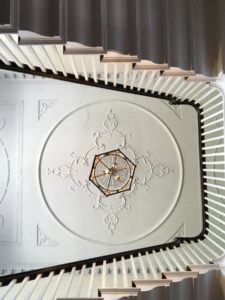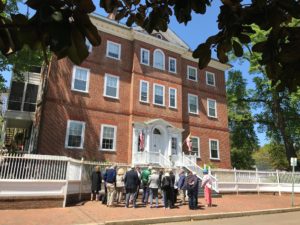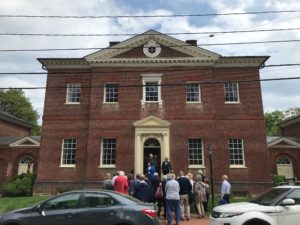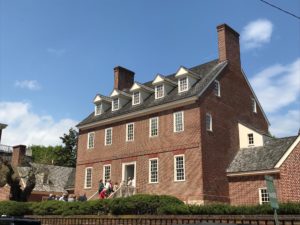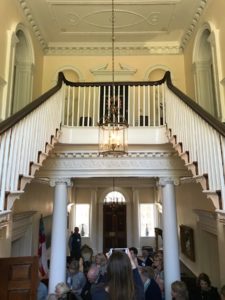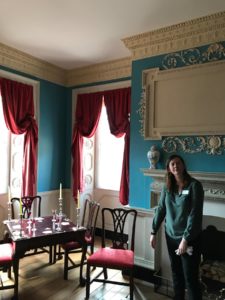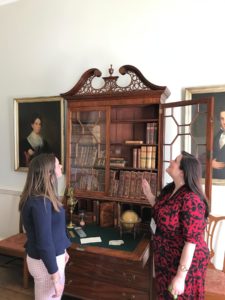William Buckland and Annapolis’ Architectural Apogee
EVENTS > SYMPOSIA
In Review: The Decorative Arts Trust Spring Symposium, 2019
by Paul Koch
On December 19, 1774, “An Inventory of the Goods and Chattels of William Buckland, late of Anne Arundel County, deceased” was recorded. Books represented only a small portion of his estate, but the bulk of his collection dealt with architecture, furniture, carving designs, and the theory and practice of building, such as:
- Isaac Ware’s Complete Body of Architecture
- James Gibbs’ A Book of Architecture, Containing Designs of Buildings and Ornaments
- Abraham Swan’s The British Architect. or The Builder’s Treasury of Stair-Cases
- Abraham Swan’s A Collection of Designs in Architecture
- William Salmon’s Palladio Londinensis: Or, The London Art of Building
- Batty Langley’s The City and Country Builder’s and Workman’s Treasury
of Designs - Thomas Chippendale’s The Gentleman and Cabinet-Maker’s Director
- Joshua Kirby’s Dr. Brook Taylor’s Method of Perspective Made Easy,
Both in Theory and Practice - Timothy Lightoler’s The Gentleman and Farmer’s Architect
- Batty and Thomas Langley’s Gothic Architecture Improved and An Historical Dissertation on Gothic Architecture
- Thomas Johnson’s One Hundred and Fifty New Designs
- Thomas Hoppus’ Practical Measuring Made Easy to the Meanest Capacity
- Abraham Swan’s The Carpenter’s Complete Instructor
- Robert Morris’ Architecture Improved, in a Collection of Modern, Elegant
and Useful Designs
How and when Buckland assembled his architectural and design library is unknown, but several of these sources influenced his finest surviving work in Annapolis.
Born in Oxford in 1734, William was the son of Francis and Mary Buckland. In April 1748, he was apprenticed to learn the joinery trade with his uncle, James Buckland, in London. After completing his apprenticeship in 1755, Buckland could have remained in Britain. With little prospect for advancement, however, he indentured himself as joiner to serve for four years at Gunston Hall, the home of George Mason in Fairfax County, VA.
As with most of the commissions he would receive in Colonial America, Mason tasked Buckland with planning and completing the interiors of a dwelling that was already under construction prior to his hire. When Buckland’s indenture was completed in 1759, Mason wrote him a letter of recommendation stating that he was “a complete Master of the Carpenter’s and Joiners Business both in Theory & Practice.” By late 1761, Buckland relocated to Richmond County, VA, and worked on several buildings in the region, including Mount Airy, the plantation house of John Tayloe II. In September 1771, Buckland accepted an offer from Edward Lloyd IV to complete an Annapolis townhouse started by Samuel Chase in 1769. Within a year, he moved his family, slaves, and workers to Annapolis. Lloyd was one of the wealthiest men in Maryland and had married Elizabeth Tayloe, daughter of Buckland’s former client at Mount Airy. Therefore, Lloyd was probably familiar with Buckland’s talents and eager for the architect to produce an elegant interior within his recently acquired Annapolis home.
Several features in the Lloyd house were likely taken from books in Buckland’s library. Plate 60 from Ware’s Complete Body of Architecture shows the ground floor plan for the Chesterfield House in London, which Ware designed and built for the 4th Earl of Chesterfield between 1747 and 1749. These drawings likely inspired Buckland’s design for the grand staircase at the Chase-Lloyd House, which appears from behind a columned arcade as a single flight backlit on the first landing by a large Venetian window before splitting into a double stair that leads to a formal area on the second floor. Although less ornate than the Chesterfield House staircase and executed in wood rather than marble and decorative ironwork, Buckland’s example is perhaps more dramatic than Ware’s original. Upon entering Chase-Lloyd, this feature immediately draws the visitor’s attention. At Chesterfield House, the staircase was placed out of view to the right of the entrance. Buckland knew exactly how to impress the visitor by evoking the power and prestige of his client. Another element of the Chase-Lloyd House inspired by Ware is the exterior design of the abovementioned Venetian window at the rear of the house, which corresponds to a design in Plate 66.
By November 1772, Lloyd hired local builder William Noke to oversee the completion of the Chase-Lloyd House while Buckland was moving forward with other projects. Matthias Hammond retained Buckland to design and build a house directly across the street from Lloyd. Like Lloyd, Hammond was eager to demonstrate his wealth and sophistication through an impressive edifice, following a trend set in Annapolis by William Paca in the 1760s. Of Buckland’s surviving work, the dwelling, known today as the Hammond-Harwood House, was the only project over which he had complete control from start to finish. It is considered his masterpiece and was completed shortly before his death in 1774.
A potential design source for the dining room chimneypiece in the Hammond-Harwood House is Plate L1 from Abraham Swan’s The British Architect, which contained “A great variety of New and Curious Chimney-Pieces” and “Corbels, Shields and other beautiful Decorations.” Buckland’s copy of Thomas Johnson’s One Hundred and Fifty New Designs is an over-the-top design guide for Rococo carving. Although there is no evidence that Buckland copied any of the plates for his Annapolis work, he likely used this source for a specific style of vine, tendril, or flourish found in the carved work of the dining room of the Chase-Lloyd House and dining and drawing rooms of the Hammond-Harwood House.
By the time of his death in November 1774, Buckland had assembled a library that was an excellent cross section of 18th-century British architectural design and building practices, which he used to great advantage on behalf of his elite patrons in Virginia and Maryland. Ranging from Baroque and Palladian to Rococo and Gothic Revival, Buckland’s library ensured he was fully prepared to meet the aspirations of the colonial gentry.
NOTES:
1 Anne Arundel County MD Prerogative Court Inventories, Liber 125, folio 337-342; taken 19 December 1774; entered, 3 June 1777.
2 Beirne, Rosamond Randall and Scharf, John H.: William Buckland 1734–1774, Architect of Virginia and Maryland. Board of Regents, Gunston Hall and Hammond-Harwood House Association. Reprint 1970, pp. 1–4.
3 Ibid. pp. 10-11.
4 bid. p. 30.
5 Ibid. p. 36.
6 Ibid. pp. 82–83.
7 Sykes, Christopher Simon: Private Palaces, Life in the Great London House. New York: Viking-Penguin, Inc. 1986, pp. 115–122.
8 Ware, Isaac: Complete Body of Architecture, Adorned with Plans and Elevations, from Original Designs. London: T. Osborne and J. Shifton, 1756.
9 Beirne and Scharf. p. 86
10 Ibid. pp. 90–91.
11 Swan, Abraham: The British Architect. The Builder’s Treasury of Stair-cases. London: Printed for the Author: and Sold by Thomas Meighan. and W. Meadows, 1745.
12 Johnson, Thomas: One Hundred and Fifty New Designs. London: Robert Sayer, 1761.

